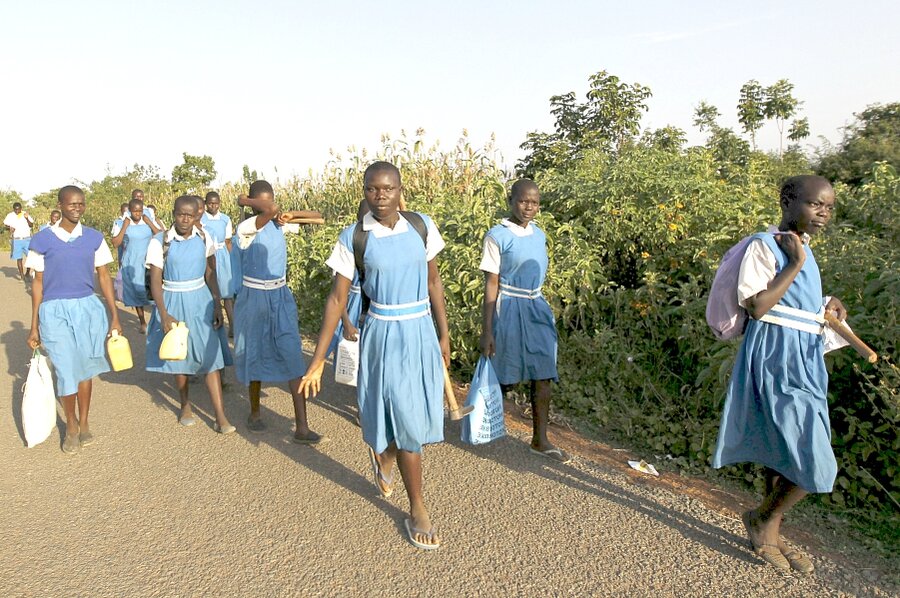School gardens fight hunger in developing countries
Loading...
Every day, Fatouma walked 6 kilometers (3.7 miles) to her school in Senegal knowing lunch would not be waiting. Her family could not afford it. By the time she arrived, she was too tired to learn. At eight years old, undernutrition had left Fatouma with the stunted figure of a five-year-old.
Free school lunches could change her life.
School-aged children, hungry for both the knowledge and nutrition they need to become healthy, successful adults, are at a mentally and physically pivotal developmental stage. However, if one of these hungers is left unsatisfied, the other suffers as well. Without proper nutrition, children cannot focus on learning, and without education, children are often limited to a life of poverty.
The developing world abounds with diet-related health and nutrition issues, both due to a general lack of food and to the increasing accessibility of fast food. The World Health Organization estimates that undernutrition leads to 3.1 million child deaths annually, and caused 45 percent of all child deaths in 2011. Undernutrition also magnifies the effect of diseases such as diarrhea, malaria, and pneumonia by over 50 percent.
But solutions exist. Governments and partner organizations have become increasingly interested in the potential of school gardens to help overcome this nutritional crisis. With benefits extending beyond the classroom, a school garden is a holistic investment in a child’s future:
- Nutrition: By raising awareness of healthy eating, gardens can combat the hunger and micronutrient deficiencies that so frequently cause irreversible damage to children's growing bodies.
- Culture: The U.N. Food and Agriculture Organization recognizes that a variety of beliefs and attitudes can negatively affect health. For example, in some cultures meat is reserved for men and people aspire to eat “luxury items” like fried chicken and chips. Where processed or fast food is sought after, nutritious indigenous vegetables and fruits are seen as “poor people’s food.” Dispelling these assumptions can both deepen nutritional and cultural understanding.
- Education: A school meal provides strong incentive to send a child to school. Once in school, a well-fed child is both less likely to drop out and more likely to focus on lessons.
- Local Market: Locally produced food can benefit the local economy while revenues sustain the school garden program.
- Community Hunger: Children who learn creative agricultural techniques can handle situations that might have caused community-wide food shortages in the past.
- Environment: Garden activities have been shown to improve children’s attitudes towards the environment, especially when these activities generate a practical understanding of the ecosystem.
As the deadline for the United Nations’ 2015 Millennium Development Goals nears, concerns surrounding its top two priorities – halving hunger and universalizing primary education – have broadened. Although dramatic progress has been made toward both goals since the turn of the century, Sub-Saharan Africa still lags behind the rest of the world on both fronts.
In Ghana, school lunch fees rank high on the list of financial obstacles to education. In Kenya, the Ministry of Planning and National Development estimates that 50 percent of children in pre-primary, 10 percent in primary, and 5 percent in secondary schools rely completely on school lunches. With most schools unable to supply these lunches affordably, however, nutritional stunting continues to affect about one-third of Kenya’s children.
Successful school gardens can be an important tool to providing much-needed food, while combating costly fees. They also align perfectly with the U.N.’s “Quick Wins” – actions that can be taken immediately to produce dramatic results within three to five years. One “quick win” urges schools to provide free, locally grown meals. This is exactly what school garden projects aim to accomplish.
Although some garden initiatives fail due to a lack of resources, motivation, or expertise, a number of flourishing programs provide excellent examples for others:
- Belize’s GATE program, organized by Plenty Belize, has a long-term program to help schools develop organic school gardens. Some of its schools, which have grown by over 40 since the program began in 2002, are now processing food with solar dryers and canning equipment, installing solar pumps and see-saw pumps. The Telefood Report 2005 described the program as “a working model worthy of replication.”
- South Africa’s EduPlant program supports schools with new gardens for two years until they can manage on their own. EduPlant also organizes workshops for educators, produces education materials, and runs an annual competition for learners’ projects.
- Uganda’s garden-based education, a large part of the country’s school curricula, is already producing tangible benefits such as practical agricultural skills, reduced school tuition, and improved health.
- Kenya’s School Garden Initiative has established 11 school gardens. While working in the gardens, children learn fine arts, math, science, history, language, and nutrition. The program’s health-conscious children also perform very well on national examinations.
School gardens can be the seed for a community’s physical health and security, but they can give more. For Marita Wyson, a 14-year-old student from Malawi, working in the garden and eating its produce made her feel strong.
“I am able to understand what my teachers are telling me,” she said. “My grandmother doesn’t have to worry so much about how she will provide food for me and my sister."
The gardens instill strength and confidence by demonstrating the possibility of immediate self-reliance, empowering children in the way all schools should.
• This article originally appeared at Global Envision, a blog published by Mercy Corps.







